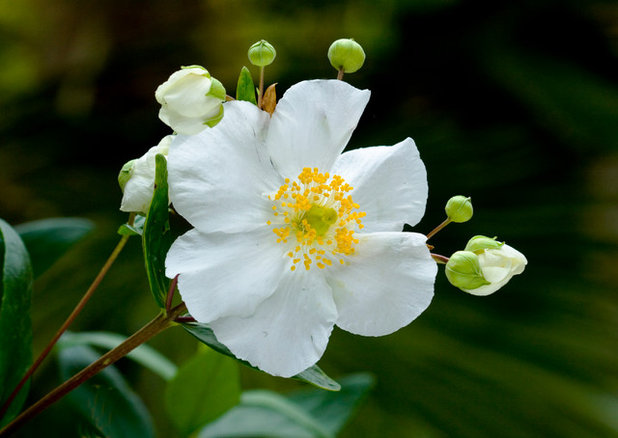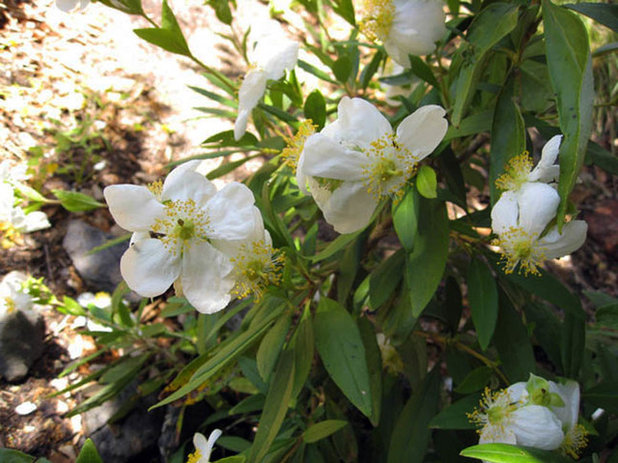Bush anemone (
Carpenteria californica) grows wild in the Sierra Nevada foothills of Fresno County, California, while the equally lovely ‘Elizabeth’ cultivar (
Carpenteria californica 'Elizabeth') brightens the shade of California gardens. 'Elizabeth' has established itself as the most prominent cultivar, and although it's not especially common, its sweet perfume and petite white flowers draw in butterflies and visitors alike.
My mom once told me that a plant without fragrance has no place in her yard. While I think she was exaggerating, I get her point. If given the option between a scent and no scent, wouldn't you choose a perfumed plant? And in the heat of summer, no fragrance quite compares to bush anemone's sweet one.

Grenville K. Godfrey
Botanical name: Carpenteria californica 'Elizabeth'
Common names: Bush anemone, California bush anemone
USDA zones: 7 or 8 to 9 or 10; hardy to 25 degrees Fahrenheit (find your zone)
Water requirement: Regular to establish; deep, occasional watering afterward
Light requirement: Full sun to partial shade (protect it in the hottest climates)
Mature size: 4 to 6 feet tall and wide
Benefits and tolerances: Flowers attract butterflies; deer resistant; tolerates drought and coastal conditions
Seasonal interest: Flowers late spring into summer, with inconspicuous foliage
When to plant: Fall or spring

Dig Your Garden Landscape Design
Distinguishing traits. Not the straight native, 'Elizabeth' is very similar and more readily available in nurseries. it’s more compact and produces smaller, even more abundant flowers through July.
Bush anemone bursts with light in shaded areas of the garden, with its prolific clusters of white flowers and yellow stamens, as landcape designer Eileen Kelly describes it. Its flowers, which resemble those of the popular Japanese anemone, are sweetly scented; the shrub produces masses of up to 20 in terminal clusters.
The shrub slowly grows to 4 to 6 feet, with many stems pushing up from the base. Attractive, though somewhat inconspicuous, ovate dark green leaves cover it year-round. The purplish bark peels in fall, revealing a yellowish-tan bark underneath.
How to use it. Bush anemone resists oak root fungus, so you may see it nestled in the shade of a sprawling oak. Its shade tolerance and lush foliage and flowers lend themselves to a native California woodland garden.

Dig Your Garden Landscape Design
Planting notes. Remember the native climate and environment of bush anemone when planting and tending it. Provide shade, especially in the afternoon, in the hottest climates and give little to moderate water — occasional deep waterings in summer. Drip lines are ideal. Provide good drainage; bush anemone does well in sandy soil on slopes. It doesn’t require pruning, but you can remove woody portions of the plant annually and pinch it back after flowering to maintain a rounded, bushy form. Check for aphids and mites periodically, spraying them off as you see them, and avoid fertilizing.
Shown: With monkey flower (
Mimulus sp)
More: Houzz gardening and landscape design guides





